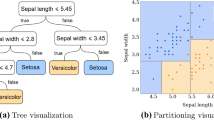Abstract
The decision tree approach is one of the most common approaches in automatic learning and decision making. The automatic learning of decision trees and their use usually show very good results in various “ theoretical” environments. But in real life it is often impossible to find the desired number of representative training objects for various reasons. The lack of possibilities to measure attribute values, high cost and complexity of such measurements, and unavailability of all attributes at the same time are the typical representatives. For this reason we decided to use the decision trees not for their primary task—the decision making—but for outlining the most important attributes. This was possible by using a well-known property of the decision trees—their knowledge representation, which can be easily understood by humans. In a delicate field of medical decision making, we cannot allow ourselves to make any inaccurate decisions and the “tips,” provided by the decision trees, can be of a great assistance. Our main interest was to discover a predisposition to two forms of acidosis: themetabolic acidosis and respiratory acidosis, which can both have serious effects on child's health. We decided to construct different decision trees from a set of training objects. Instead of using a test set for evaluation of a decision tree, we asked medical experts to take a closer look at the generated trees. They examined and evaluated the decision trees branch by branch. Their comments show that trees generated from the available training set mainly have surprisingly good branches, but on the other hand, for some, no medical explanation could be found.
Similar content being viewed by others
REFERENCES
Kolok, P., Zavrsnik, J., Zorman, M., Malcic, I., and Kancler, K., Participative design, decision trees, automatic learning and medical decision making. In J. Bender (ed.), Medical Informatics Europe '96(Studies in health technology and informatics, Vol. 34), Amsterdam [etc.]: IOS Press; Tokyo: Ohmsha, 1996, pp./A 501–505.
Stuart, J., Russel, Norvig, P., et al., Artificial intelligence: A modern approach, Prentice-Hall, Englewood Cliffs, ch. 18, pp. 525–562, 1995.
Hunt, E. B., Martin, J., and Stone, P. J., Experiments in Induction, Academic Pres, New York, 1966.
Quinlan, J. R., Induction of decision trees. Machine Learn.81–106, 1986.
Selby, R. W., and Porter, A. A., Learning from examples: Generation and evaluation of decision trees for software resource analysis. IEEE Transactions on Software Engineering, Vol. 14, No. 12, pp. 1743–1757, December 1988.
Quinlan, J. R., Simplifying decision trees. Int. J. Man-Machine Studies. 221–234, 1987.
Quinlan, J. R., C4.5: Programs for Machine Learning, Morgan Kaufmann Publishers, San Mateo, CA, 1993.
Quinlan, J. R., Decision Trees and Instance-Based Classifiers. CRC Computer Science Engineering Handbook(A. B. Tucker, Jr., ed.), CRC Press, ch. 22, pp. 521–535, 1997.
Kokol, P., Stiglic, B., mer, V., Metaparadigm: a soft and situation oriented MIS design approach. Int. J. Bio-Med. Comput.39:243–256, 1995.
Baeck, T., Evolutionary Algorithms in Theory and Practice, Oxford University Press, Inc., 1996.
Holland, J. H., Hidden Order, How Adaption Builds Complexity, Addison-Wesley Publishing Company, 1995.
Rose, B. D., Clinical Physiology of Acid-Base and Electrolyte Disorders, McGraw-Hill, New York, pp. 478–757, 1989.
Knuck, F., Saure-Basen Haushalt. In W. Siegenthaler, ed.), Klinische Patophysiologie(sixth edition), Thieme Verlag, Stuttport, pp. 238–249, 1987.
McCarthy, P. L., Pathophysiology of Body Fluids, In W. E. Nelson, V. C. Vaughan, R. J. McKay, R. E. Behrman, eds.), Textbook of Pediatrics(14th edition), Saunders, Philadelphia, pp. 176–185, 1992.
van der Walt, J., Sweeney, D. D., Runciman, W. B., and Webl, R. K., Paediatric incidents in anaesthesia: An analysis of 2000 icident reports. Anaesthes. Intensive Care21: 655–658, 1993.
Cohen, M. M., Cameron, C. B., and Duncan, P. G., Pediatric anesthesia, morbidity and mortality in the perioperative period. Anesthy Analg.70: 60–70, 1990.
Altemeyer, K. H., and Kraus, G. B., Die perioperative Infusionstherapie in Kindesalter. Anaesthesist39:135–143, 1990.
Lovell, B. C., and Bradley, A. P., The multiscale classifier. IEEE transactions on pattern analysis and machine intelligence, Vol. 18, No. 2, February 1996.
Author information
Authors and Affiliations
Rights and permissions
About this article
Cite this article
Zorman, M., Štiglic, M.M., Kokol, P. et al. The Limitations of Decision Trees and Automatic Learning in Real World Medical Decision Making. Journal of Medical Systems 21, 403–415 (1997). https://doi.org/10.1023/A:1022876330390
Issue Date:
DOI: https://doi.org/10.1023/A:1022876330390




